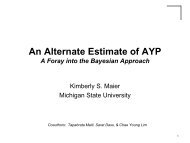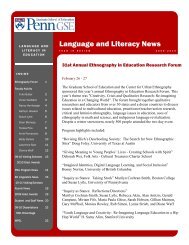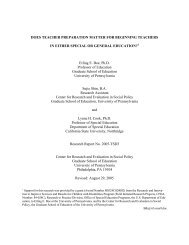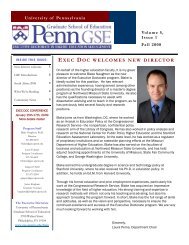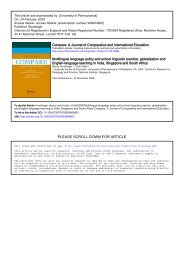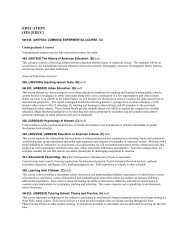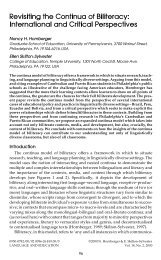Teacher turnover in special and general education: attrition
Teacher turnover in special and general education: attrition
Teacher turnover in special and general education: attrition
Create successful ePaper yourself
Turn your PDF publications into a flip-book with our unique Google optimized e-Paper software.
<strong>Teacher</strong> Turnover<br />
Dest<strong>in</strong>ation of School Migrants<br />
Based on aggregated school migration data for the 1990s, 9.4% of public school SETs <strong>and</strong><br />
7.1% of GETs migrated from one school to another annually. Of those who moved, well over<br />
half migrated to schools with<strong>in</strong> the same LEA (62.3% of SETs; 52.5% of GETs, from Table 2).<br />
Slightly over half of with<strong>in</strong>-LEA migration was <strong>in</strong>voluntary on the part of teachers; it was<br />
reassignment by adm<strong>in</strong>istrative decision (Boe, Barkanic, & Leow, 1999).<br />
Most other movers went to other LEAs <strong>in</strong> the same state (29.8% of SETs; 34.7% of GETs),<br />
while the rema<strong>in</strong><strong>in</strong>g small percentage of movers went out of state or to private schools.<br />
Results: Attrition, Transfer, <strong>and</strong> Migration Comb<strong>in</strong>ed<br />
As seen <strong>in</strong> Figure 9, the total annual <strong>turnover</strong> (the sum of <strong>attrition</strong>, teach<strong>in</strong>g area transfer,<br />
<strong>and</strong> school migration) of SETs <strong>and</strong> GETs <strong>in</strong>creased substantially dur<strong>in</strong>g the n<strong>in</strong>e-year period<br />
from 1991-92 to 2000-01. Turnover <strong>in</strong>creased 60% for all public teachers (from 478,000 to<br />
767,000 annually). These total <strong>turnover</strong> numbers are unduplicated counts. That is, teachers who<br />
both switched teach<strong>in</strong>g area <strong>and</strong> moved to a different school are counted only once.<br />
Some of this <strong>in</strong>crease <strong>in</strong> the numbers of teachers turn<strong>in</strong>g over might be expected because the<br />
teach<strong>in</strong>g force grew dur<strong>in</strong>g these years. However, the rate of total <strong>turnover</strong> for all public teachers<br />
likewise <strong>in</strong>creased substantially (from 18.8% <strong>in</strong> 1991-92 to 25.62% <strong>in</strong> 2000-01, a 36% <strong>in</strong>crease).<br />
Moreover, the number of teachers turn<strong>in</strong>g over per public school <strong>in</strong>creased from 5.66 <strong>in</strong> 1991-92<br />
to 8.34 <strong>in</strong> 2000-01 (a 47% <strong>in</strong>crease).<br />
Based on aggregated data for 1991-92, 1994-95, <strong>and</strong> 2000-01, the total annual <strong>turnover</strong> of<br />
public school teachers was virtually identical for SETs <strong>and</strong> GETs (22.8% <strong>and</strong> 22.4%,<br />
respectively). The magnitude of <strong>in</strong>dependent components of teacher <strong>turnover</strong> is shown <strong>in</strong> Table<br />
3. S<strong>in</strong>ce <strong>attrition</strong> only accounted for about 30% of total <strong>turnover</strong>, the substantial majority of<br />
<strong>turnover</strong> lies with<strong>in</strong> the ranks of employed teachers. While this poses problems for staff<strong>in</strong>g<br />
schools <strong>and</strong> teach<strong>in</strong>g areas from which teachers depart, it contributes to solv<strong>in</strong>g staff<strong>in</strong>g<br />
problems for schools <strong>and</strong> teach<strong>in</strong>g areas that such teachers enter. At least <strong>turnover</strong> with<strong>in</strong> the<br />
national teach<strong>in</strong>g force does not require replacement teachers to be recruited from outside the<br />
force.<br />
As seen <strong>in</strong> Table 3, there were some differences between SETs <strong>and</strong> GETs <strong>in</strong> the extent of<br />
various types of <strong>turnover</strong>. SETs were somewhat less likely to switch teach<strong>in</strong>g areas than GETs,<br />
while SETs were somewhat more likely to move to a different school than GETs. Consider<strong>in</strong>g<br />
26



